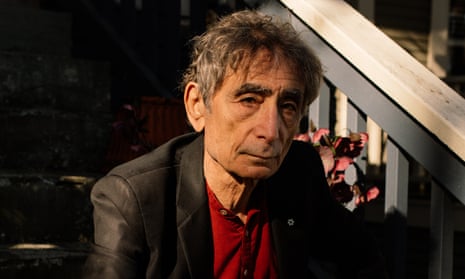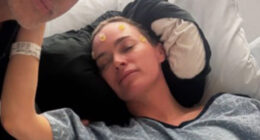
The trauma doctor: Gabor Maté on happiness, hope and how to heal our deepest wounds
The physician, author and self-help guru came to worldwide prominence when he appeared with Prince Harry last month. He discusses the mind-body connection, the reality of addiction and why trauma can be treated
Gabor Maté was arriving at Vancouver airport one day when his phone lit up with a text from his wife, Rae. She asked if he still wanted a lift home, and mentioned she hadn’t yet left their house. The physician, mental health expert and bestselling author, who was 71 at the time, replied brusquely: “Never mind.” So enraged was he, as Maté writes in his new book, The Myth of Normal: Trauma, Illness & Healing in a Toxic Culture, that, when he got home, he “growled a hello” and then “barely made eye contact” for the next day. “Is this the response of a mature adult in his eighth decade?” he asks.
This kind of candour about his failings has won him fans for his work on trauma, addiction, attention deficit disorder (ADD), stress and childhood development, but it is the wisdom he squeezes from it that has made him a self-help guru for some. With more than 1.4 million followers on Instagram, he has an impact on people akin to that of a rock star, but a cerebral one – more Leonard Cohen or Joni Mitchell than Justin Bieber (his husky drawl would sound almost as good narrating the lyrics to I’m Your Man).
Back to the airport. “At times like this, there is very little grown-up Gabor in the mix,” he writes. “Most of me is in the grips of the distant past. This kind of physio-emotional time warp, preventing me from inhabiting the present moment, is one of the imprints of trauma, an underlying theme for many people in this culture.”
The template for his hostility, he says over a video call from his home in Vancouver, against a backdrop of Indigenous art from British Columbia, is to be found in the messages he received as a Jew in Nazi-occupied Hungary. Maté was born in January 1944; in May of that year, the deportation of Hungary’s Jews to Auschwitz began. By the end of the Holocaust, 565,000 Hungarian Jews had been murdered, Maté’s maternal grandparents among them.
When he was 11 months old, his mother sent him with a stranger to be cared for by his aunt. In the book, he quotes her diary from the time: “My dear little man,” she starts, explaining that she was forced to part with him because “your little organism could not possibly endure the living conditions [in the] fenced-in Budapest ghetto”.
Maté says trauma, from the Greek for “wound”, “is not what happens to you; it is what happens inside you as a result of what happens to you … It is not the blow on the head, but the concussion I get.” That, he says, is the good news. “If my trauma was that my mother gave me to a stranger … that will never not have happened. But if the wound was that I decided as a result that I wasn’t worthwhile as a human being, I wasn’t lovable, that’s a wound that can heal at any time.”
There can be two types of wound, he says. “There’s the capital-T traumatic events,” which include things like being abused as a child and the loss of a parent. Then there are “small-T traumas”. “You can wound a kid not only by doing bad things to them, but by also not meeting their needs,” he says. Even doting parents can easily, unknowingly, inflict small-T traumas on their children. He would know, because, as he admits, he inflicted them on his own kids.
All trauma must be treated with compassion, but he is adamant that it isn’t an excuse for not taking personal responsibility. As he writes about the airport incident, there comes a point when “‘Hitler made me do it’ won’t fly”.
Trauma exists on a personal level, but also in the collective sphere – he cites the persecution of Canada’s Indigenous people and the ensuing addiction, illness and suicide, as well as the legacy of racism and slavery in the US. In most cases, he writes, trauma is multigenerational: “We pass on to our offspring what we haven’t resolved in ourselves.” Left unhealed, trauma “has an impact on your life … about how you feel about yourself, how you see the world, how you get triggered, what you believe about yourself, the kind of relationships you get into. And it shows up in the form of chronic illness.”
Even now, at 79, Maté is still discovering ways that the imprints of trauma can bubble up. Take the past few weeks. At the beginning of March, he engaged in a livestreamed conversation with Prince Harry about loss, trauma and healing. It was rapidly subjected to the same scrutiny as all things the prince touches. Maté was derided in the press as a “so-called ‘trauma expert’”; headlines pitched him as a “Holocaust survivor who hails Hamas as ‘heroes’”; and there was criticism of his diagnosis of Harry as having ADD. Also, his – stylish, it should be said – collarless shirt was belittled.
His own reaction surprised him: “I thought by this age I was past that stuff.” But the encounter with the press, and on social media, left him “roiling inside with upset and even some degree of shame”. He reached out to a psychiatrist friend who asked him: ”What is it about this whole thing that upset you so much?”
For Maté, it was not being seen. “That’s my trigger. If somebody disagrees with me, that’s great, I don’t care. But let them see me and let them disagree with what I actually say and who I actually am and not their distortion.” His friend made a link about how not feeling seen as a child seemed like a life-threatening situation to him, after he was separated from his mother. “As soon as he said that, I just released inside. I got it,” he says, exhaling visibly.
In terms of diagnosing Harry with ADD – something Maté was diagnosed with in his mid-50s – the point that was missed, he says, is that “I wasn’t diagnosing him with a disease. I said: ‘You’ve got no disease.’ I said: ‘You’ve got a normal response to abnormal circumstances. Because if a child is stressed like he was, or I was, what do you do with that stress? You can’t escape it, so what do you do? The brain tunes out … But this is happening when the brain is developing and that affects its circuitry.” While many scientists would disagree, Maté believes this is a “reversible response”.
I wonder if it must be particularly galling to see his views on Israel and Palestine represented with such clumsiness, given they have cost him so dear. When, in the immediate aftermath of the six-day war in 1967, he first made clear his opinions, his father kicked him out of the house. “I basically dared say that Israel had launched this war to occupy territory and they’ll never give it back. Now, I’m going to ask you: how wrong was it?”
READ RELATED: 7 Things People of Color Should Know About Hidradenitis Suppurativa
His early Zionism was, he says, “wonderful for me, because it made me proud to be a Jew for the first time”. But finding out “the actual history” punctured it: “The slogan about a land without a people for a people without a land. There was never a land without a people; there was a people there.”
For his parents, “who had suffered so much for being Jewish, for a Jewish young man to criticise Israel, to call its policies into question, was so painful”. While his father did, eventually, come to agree with him, it was a subject that he could never discuss with his mother. His maternal grandfather had been a Zionist leader and “to have actually looked at the reality that I was looking at would have meant a betrayal of her father who died in Auschwitz. So I understood that.”
Maté has a heightened level of compassion. Perhaps part of it is because, for him, the real villain is our culture. In The Myth of Normal, he gives the analogy of a toxic culture in a laboratory, meaning one that is “unsuitable for the creatures it is meant to support. Or worse: dangerous to their existence. It is the same with human societies.” He catalogues toxicities as: “illness born of stress, ignorance, inequality, environmental degradation, climate change, poverty and social isolation.”
We have, he says, become so “acculturated” that it has become normal, but that doesn’t mean it is healthy. The central argument of the book is: “Those features of our daily life that appear to us now as normal are the ones crying out for the greatest scrutiny.” Like crustacea placed in cold water, we haven’t noticed the heat being turned up to boiling point.
Many of the plights of modern society are, he says, natural responses to an unhealthy culture. Take addiction, something that he doesn’t just relate to drink and drugs, but also to “sex, gambling, pornography, extreme sports, cell phones”. His view is that there is no such thing as an “addictive personality”. Nor is addiction a disease. His mantra is: “Don’t ask why the addiction, ask why the pain. To understand people’s pain, you have to understand their lives. In other words, addiction is a normal response to trauma.”
Maté spent 12 years working in Vancouver’s Downtown Eastside – North America’s most concentrated area of drug use. “Every one of my female patients – many of whom were Indigenous, many caught up in the sex trade – had been sexually abused in childhood or adolescence, one marker of the multigenerational legacy born of Canada’s brutal colonial past,” he writes.
I ask why he thinks there can be such an empathy gap for people with addiction. He says that, when he was working with people addicted to hard drugs, he had his own severely addictive behaviours – “work and shopping”. He would lie to his wife about the money he had spent. “At one point, I even left a woman in labour in hospital to go and get a compact disc. I had to have it right then and there.”
He told his patients about his own behaviours. “They said: ‘Doc, you’re just like the rest of us.’ The point is, we are all just like the rest of us.” So, when it comes to addiction, he says, “people find it much easier to project that part of themselves that they don’t like on to a certain despised population than to look at themselves. What they’re actually disdaining is a part of themselves that they dare not look at.”
If your average person is, to a lesser or greater extent, acclimatised to the toxicity of our culture, like a lobster in a pot, how has Maté come to be so cognisant of it? One factor, he says, is that through his work as a family doctor he “knew people before they got sick” and could locate their illnesses in the broader context of their family, their communities and their lives.
He takes umbrage with the way medical teaching is done: “Physicians are trained in this narrow biological view, but, if your eyes are open, you can’t help but notice it.” He started reading the “vast body of literature that has demonstrated the links between emotional dynamics and physical pathology”.
He points to stress as one of many examples; he wrote about it in his 2003 book, When the Body Says No: The Cost of Hidden Stress: “[It] causes inflammation, erodes the healthy functioning of chromosomes, turns genes on that can trigger cancer.” He mentions a study that showed “women with severe post-traumatic stress disorder had double the risk for ovarian cancer. Despite the fact that this study came out four years ago, from Harvard, the average oncologist doesn’t have a clue.”
Maté is passionate about the connection between mind and body. “To say that the mind is connected to the body is incorrect,” he says. “To say that the nervous system is connected to the immune system, and the immune system is connected to the emotional apparatus, all of which is connected to the hormone system, is incorrect. They are not connected; they are the same system.”
I wonder what Maté hopes to achieve with everything he is putting out there. He thinks back to a workshop he attended five years ago, when he was asked to identify his calling and what footprint he wished to leave. “My calling is that people are free in every realm – so in the political realm, hence my stance on the Israel/Palestine conflict, but also in the personal realm, so that we’re not pulled like puppets on a string by our own personal dynamics, by trauma. You may agree with me or not agree with me, but that is my intention in everything I do.”
If he talks a bit like a thought leader, that is because, these days, he is one. He has been well known in Canada for some time, but now, in any airport anywhere in the world, someone will run up to him, crying, shaking and thanking him for his work. That must be a strange experience, I suggest. “You know, it isn’t, because I believe in my work and the truth that I am saying,” he replies.
He is well aware, he says with gentle humour, of “what a flawed little creature I am”. It is a good job that he has his head screwed on, I say, because otherwise his ego would be huge. “To correct you, my ego is huge. I just don’t believe it.”
Source: Health & wellbeing | The Guardian






